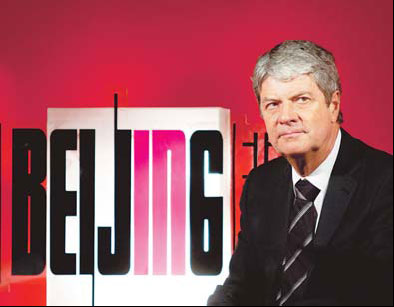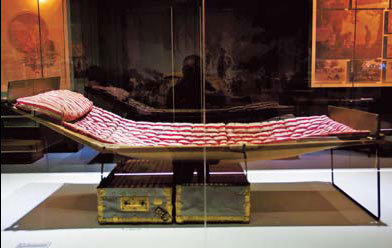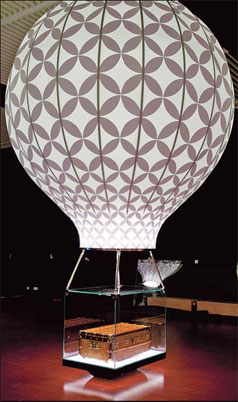Life
Journey of a trunk
Updated: 2011-06-01 08:25
By Tiffany Tan (China Daily)
|
|
|
|
An ongoing exhibition presents fascinating aspects of the Louis Vuitton story. Tiffany Tan reports.
How many people know that the luxury label that gave fashionistas the Monogram Speedy bag also created beds that folded into luggage trunks and spare-tire holders that doubled as hat containers? Or, that it custom-made travel writing desks, portable closets for 30 pairs of shoes as well as an iPod trunk? This summer, Louis Vuitton puts the spotlight on its 150-year history of craftsmanship and innovation in the exhibition Voyages, which opened on May 31 and runs until Aug 30 at the National Museum of China.
The show, which presents some 200 items from the Louis Vuitton archives as well as private collections, takes visitors to the French fashion house's beginnings as a trunk maker to 19th century European aristocracy, namely Empress Eugenie of France (1826-1920).
"We started in China nearly 20 years ago. It's now a brand-new generation to whom it's also important to tell how the past of Louis Vuitton explains the reality of today," says Yves Carcelle, chairman and CEO of Louis Vuitton, who visits China four to six times a year and sneaks in time between business meetings to go sightseeing around the country.
The company's founder and namesake, Louis Vuitton, forged his brand's reputation by supplying made-to-order luggage to explorers, artists and celebrities. Over time, changes in the label's travel products and designs reflected developments in mass transportation since the company's founding in 1854.
|
|
A mail trunk in striped canvas - conspicuous for the multicolor hotel stickers that now cover its surface - was created in 1885 for train or ship travel. Two decades later, Louis Vuitton patented the watertight Aero trunk for a hot-air balloon gondola, which "guaranteed to keep the gondola afloat if they fell in the sea".
In 1910 came the Auto Jack trunk in Monogram Canvas. It was among the tool kits designed to "enhance the comfort of automobile pioneers" who had to cope with frequent flat tires and breakdowns owing to poor road conditions. Fast forward a century, to the age of frequent flyer miles, and the label now offers a lightweight, carbon-fiber version of its popular Keepall travel bag.
"When the builders of spaceships will think of including luggage holds in their designs, we may well have room to put one of our suitcases," Patrick Louis Vuitton, the founder's great-great-grandson, says in one of the videos on exhibit.
Meanwhile, Carcelle, in an exclusive interview with China Daily before the exhibition's opening, emphasizes the design house's widening scope: "We continue to create innovations in travel, but of course from the original world of travel we extended the world of Louis Vuitton to not only a companion of travel but a companion of life."
The luggage maker's expansion into handbags and clothing - as well as its partnership with artists from across the globe - is also integrated into the exhibition.
There's Swiss pop artist Sylvie Fleury's Vuitton Bag in Chromed Bronze (2001), which inspired Louis Vuitton's artistic director Marc Jacobs to create the Monogram Mirroir bags. A few display cases away are clothes by US painter and photographer Richard Prince as well as ones by US fashion designer and artist Stephen Sprouse.
Another collaboration, one that's almost impossible to miss, is The Beginning (2011), a video installation by Chinese artist Zhan Wang. The video, presented on a giant screen inside a capsule of mirrors, shows in slow motion the explosion of a 5-meter-long rock resting on a platform: the artist's attempt to explain what compels people to travel.
"People want to find the origin of the universe, but I think this origin is found inside us," Zhan, a 48-year-old Beijinger, says. "If you find this origin, then you will understand the reason why you need to travel and why you're always on the way."
The artwork appealed to Louis Vuitton as a re-imagination of the Big Bang Theory, which echoes the theme of Voyages.
"We thought it was the perfect symbol to start an exhibition on travel because the Big Bang was the first travel of the world. It's Day One of the world," says Carcelle, a self-confessed collector of contemporary Chinese art, including works by Zhan, Zeng Fanzhi and Zhang Xiaogang.
As Louis Vuitton strives to remain the world's top luxury brand, it recognizes the significance of the Chinese market.
"The sophistication of the customers in China follows the same trend in the rest of the world, but it happens even more quickly here," says Carcelle, who has just returned from a dream trip to the Yellow Mountains in Anhui province. "You succeed in a country if you love the country and love the culture and understand it."
(China Daily 06/01/2011 page21)
Specials

Room at the inn
The Chinese hotel industry experiences a building boom, prompting fears of oversupply.

Pearls of wisdom
Chinese pearl farmers dominate the world market but now want to work smarter, not harder

Truly a super woman
Li Yuchun first came to prominence in 2005 as the Super Girl winner, and since then has become an international star.


